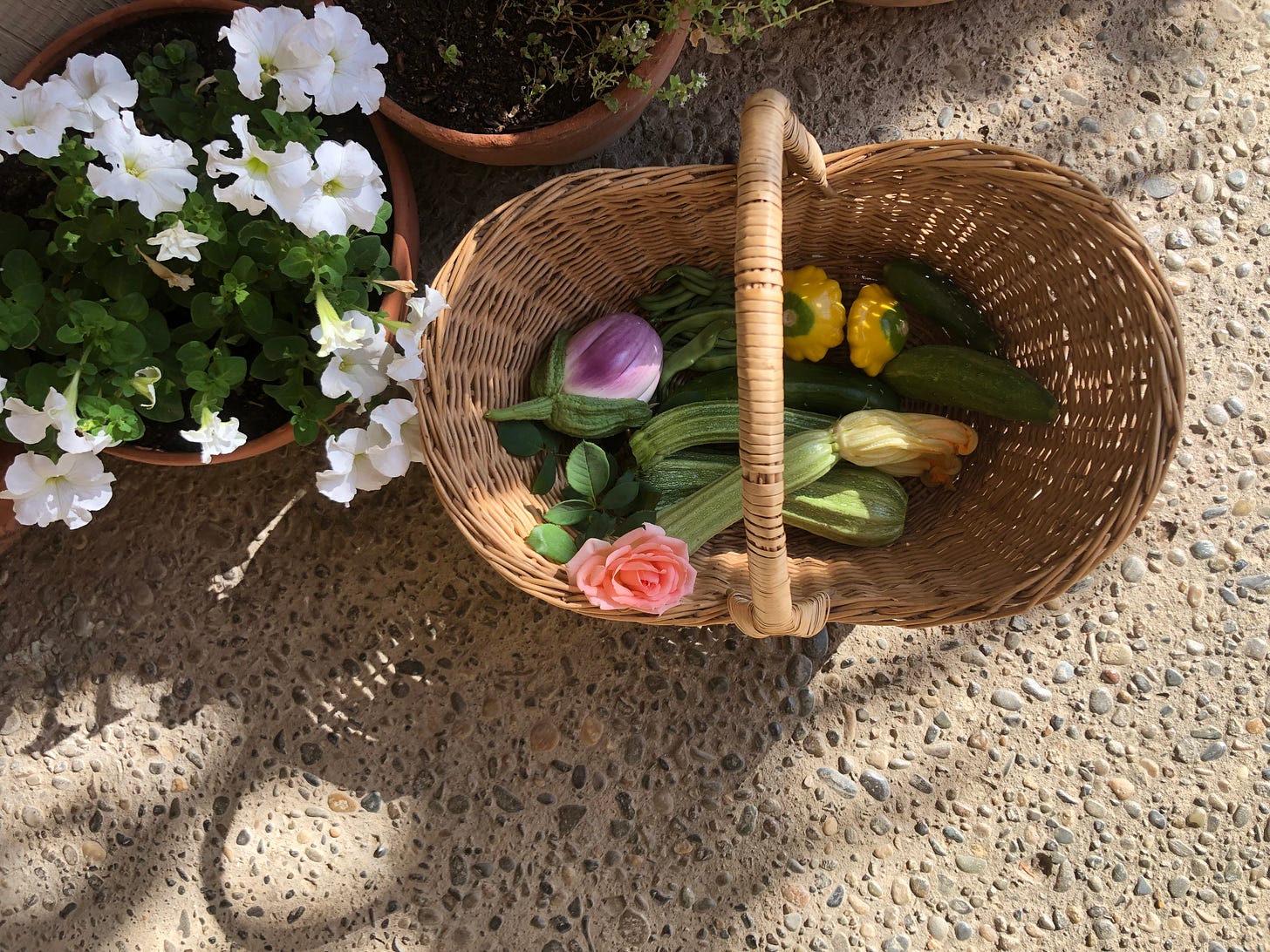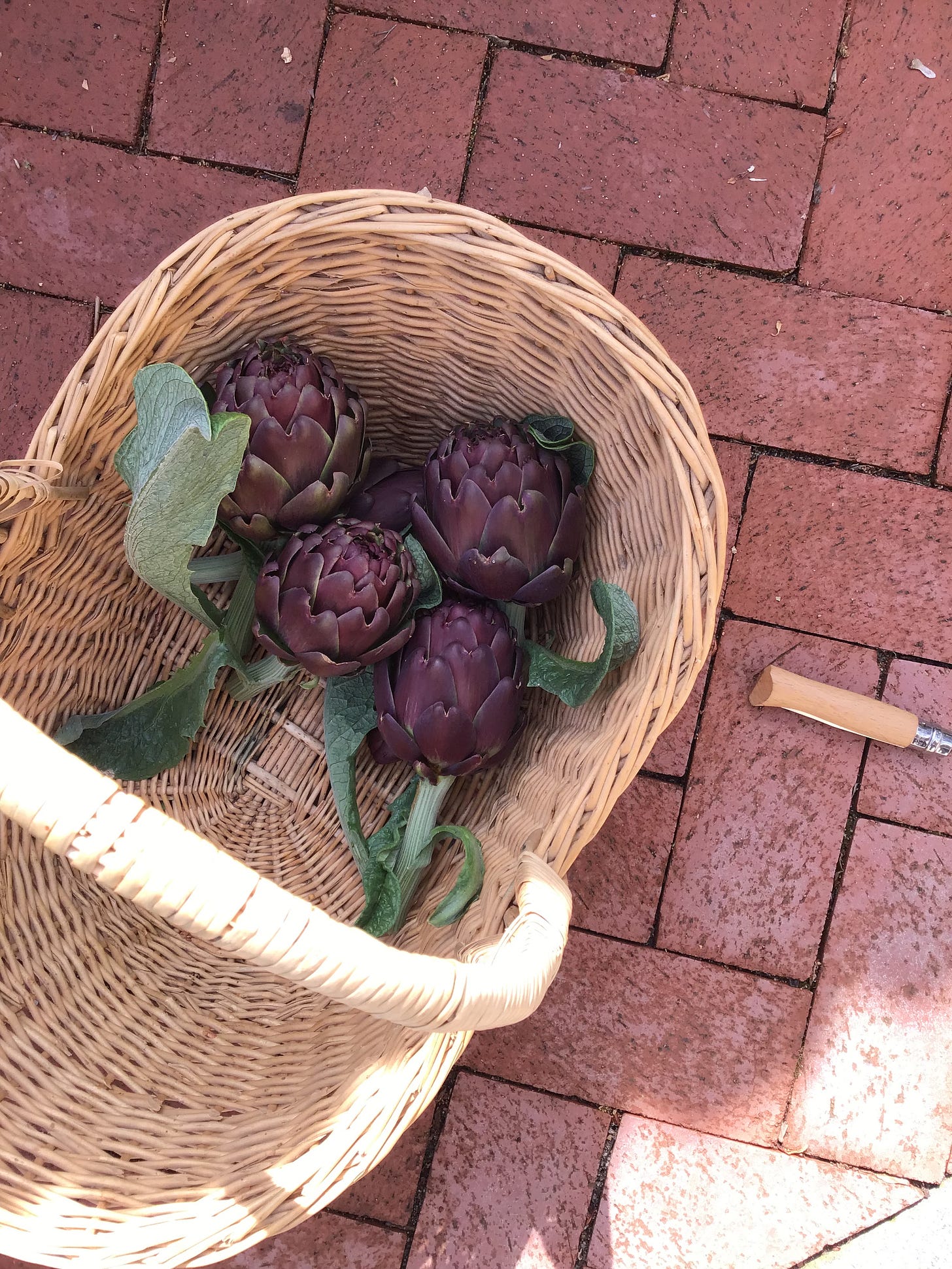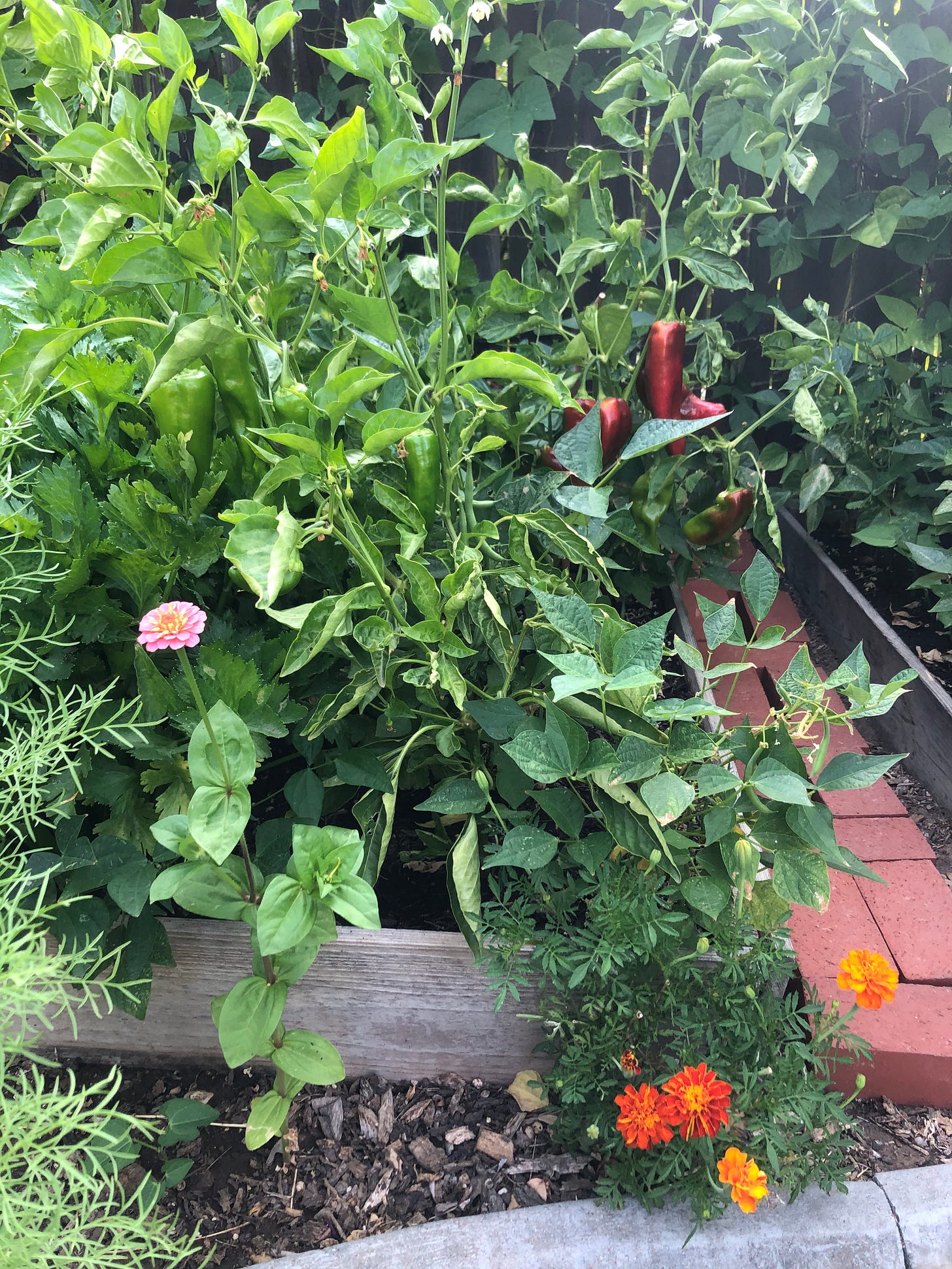Welcome to mamaeats, a twice-weekly newsletter (Tues. & Sat.) inspired by a simple + seasonal home life. I’m a mother of three, avid reader, gardener, and home cook who focuses on nourishing, whole food meals with a focus on plants. This newsletter is my labor of love—if you are not already, and are able to do so, please consider becoming a subscriber to support my work here, which takes time and effort. Doing so gives you access to all the archives and recipes (find the recipe index here), as well as cook-along videos which go along with most recipes. If a recurring payment is too much for you right now, but you’d still like to contribute, I’d be delighted to receive a one-off tip via my ko-fi. As always, thank you for being here, reading this newsletter, and sending me your thoughts.
Hello friends! Melissa wrote in to ask if I would share more about my garden soon (thanks for this idea!), so I thought I’d send a little postcard of goings-on lately. A snapshot of the mid-May garden. This is a long newsletter with lots of information and photos, but I hope you’ll enjoy it. At the end, there’s a garden tour video for paid subscribers- thank you!
A little background: I garden in zone 9b, in the valley of northern California. We have a pool that takes up a good portion of our backyard, along with a good amount of concrete. I essentially have a border perimeter strip along the fence line in which to plant. It’s not tiny, but it’s not large, either. When we moved here (we rent from family), there were a few established fruit trees, several roses, and little else besides shrubs, grass, and ivy. Over the years, I’ve worked really hard to coax this little patch of earth into a food garden, flower garden, and overall pleasant place to be for our family.
Although we always had a vegetable garden growing up (and so did my grandparents, in true Italian fashion), I unfortunately didn’t pay much attention and thus had to learn most things from scratch in my late twenties. I tell you this because I think alot of people get discouraged when they start gardening, and aren’t perfect at it right away. There will be plenty of mistakes you make, or inevitable crop failures- and that’s ok! Even for a seasoned gardener, these things happen—it’s why gardening is so humbling. However, each time you grow something, you learn what to do better next time. You learn what varieties work best in your area, you learn how to control the pests you get, you learn how to take care of your soil and make the most of your space. Gardening is not only a very helpful skill, it’s also fantastic for mental health. It’s a huge part of how I manage stress.

Some practical notes on the nuts and bolts of things: I don’t add anything to my soil except compost and manure, twice a year: spring and autumn. I mostly follow the no-dig method, as learned from Charles Dowding (highly recommend his YouTube channel). For seed starting, I like Fort Vee Compost-Based Potting Mix if I’m using a soil blocker, or my own homemade compost if I’m using seed trays. I use Charles Dowding’s hot compost method to make it, of which you can read an extraordinary amount of free information here, or through his videos on the subject here. I also plant intensively to make the best use of our small space- meaning, I often plant things more closely together than seed packets state, and I pop new starts for the next season in the ground even when the original crop is not quite ready to be removed. For example, in the October garden: tomatoes still fruiting, basil on the left not ready to go yet, but I’ve still started seeds for cabbage and popped in those starts next to them in order not to lose time/space. You’ll also notice I always mix flowers in the vegetable garden- for joy, pollination, maximal use of space, and beauty.

Now, to the fun part: what’s growing in the summer vegetable garden this year?
summer vegetable garden:
cucumbers: China Jade (very long, dark green slicer), Shintokiwa, Vorgebirgstrauben (pickling)
cherry/cocktail sized tomatoes: Wooly Kate, Riesentraube, Grappoli D’inverno, Sun Gold
slicer tomatoes: Early Girl, Striped German, Costoluto Genovese, Black Krim
zucchini: Ronde de Nice (round for stuffing), Lunga Fiorentino
peppers: Jimmy Nardello, Corbaci, Corno di Toro Rosso
basil: Tigullio, Bolloso Napoletano, Aurelia
green beans: Spanish Musica, Blue Lake
winter squash: Red Kuri, Marina di Chioggia, Honeynut

established/perennial fruiting trees and plants:
Montmorency sour cherry
Parfianka pomegranate
Blenheim apricot
raspberries, variety unknown originally from my grandmother’s garden
Santa Rosa plum
Concord grape
Honey Babe dwarf peach
Pink Lady apple
clementine, unknown variety
strawberry patch, a mix of June-bearing, Ever-bearing, and fraises des bois
Carciofo Romanesco artichoke
established herbs:
an aside: if there is one thing you plant, whether you live in an apartment with just a windowsill, or are lucky to have a large green space: herbs! In pots, in the ground, whatever. You will save so much money not buying those little plastic clamshells of herbs, and they taste so much better fresh, and you can cut exactly what you need. They are easy, they are beautiful, they are tasty.
thyme
sage
rosemary
oregano
marjoram
lemon verbena
lemon balm
chives, I planted these in our strawberry patch and they come back every year
mint
garden tasks in May
May is a period of transition for the garden, from spring to summer. There’s quite a bit of work to be done, to establish the summer crops well and to remove spent spring plants and blooms.
deadheading: the first flush of roses has finished, and deadheading is an important job to keep the bushes looking fresh, well shaped, and ready to bloom again. To do this, I cut back the stem with the spent rose to just above the first true leaf (a leaf that has five leaflets/parts). I also cut back any stems that have grown disproportionately long back to match the height of the rest of the rosebush, to maintain its shape.
cutting back: similar to deadheading, some of the plants in my garden, such as the catmint, marjoram, and sage, have finished blooming and gotten quite elongated/leggy, so they benefit from being cut back so that new growth can begin again. For the sage, I simply remove spent flowerheads to right above the next leaves. For the catmint and marjoram, I cut back to 1/3 of the original size. This allows new growth to begin again and keeps the plant nicely rounded and bushy.
allowing annuals to seed out: Although some plants may be finished with their life cycle, I allow them to continue growing in order to allow them to make seed to either save or to ensure they self-sow for the following year. Mostly, this includes my annual spring flowers: pansies, larkspur, icelandic and breadseed poppies, nigella, sweet peas—but also cilantro, chives, and parsley.
remove spent foliage from bulbs: bulbs need their foliage even after blooming is finished, as the leaves store up energy in the bulb for next year’s bloom. When the foliage has all turned yellow and withered, I then remove it (to the compost) to keep the garden tidy. Tulip foliage I remove right after blooming, as in our climate they will not rebloom, or will rebloom quite weakly. I also make a note of where I’d like to put more bulbs next year, and divide/remove any bulbs as needed.
deep water fruit trees: our climate is a dry Mediterranean type, with long, dry, hot summers. We often don’t get rain from May-October, and temperatures rise to the 90s this month. Mid way through the month, I begin deeply watering fruit trees in the yard.
continue to start seeds for succession planting of annual flowers and vegetables, and plant any last additions to the vegetable garden: I have started more seeds of cosmos, basil, and winter squash to fill in any open spaces and ensure a staggered supply throughout the season. I also bought one more cherry tomato start (an heirloom, ‘Black Cherry’) as all my children (and I!) love to pick and eat cherry tomatoes, and I had a little more space to fill.
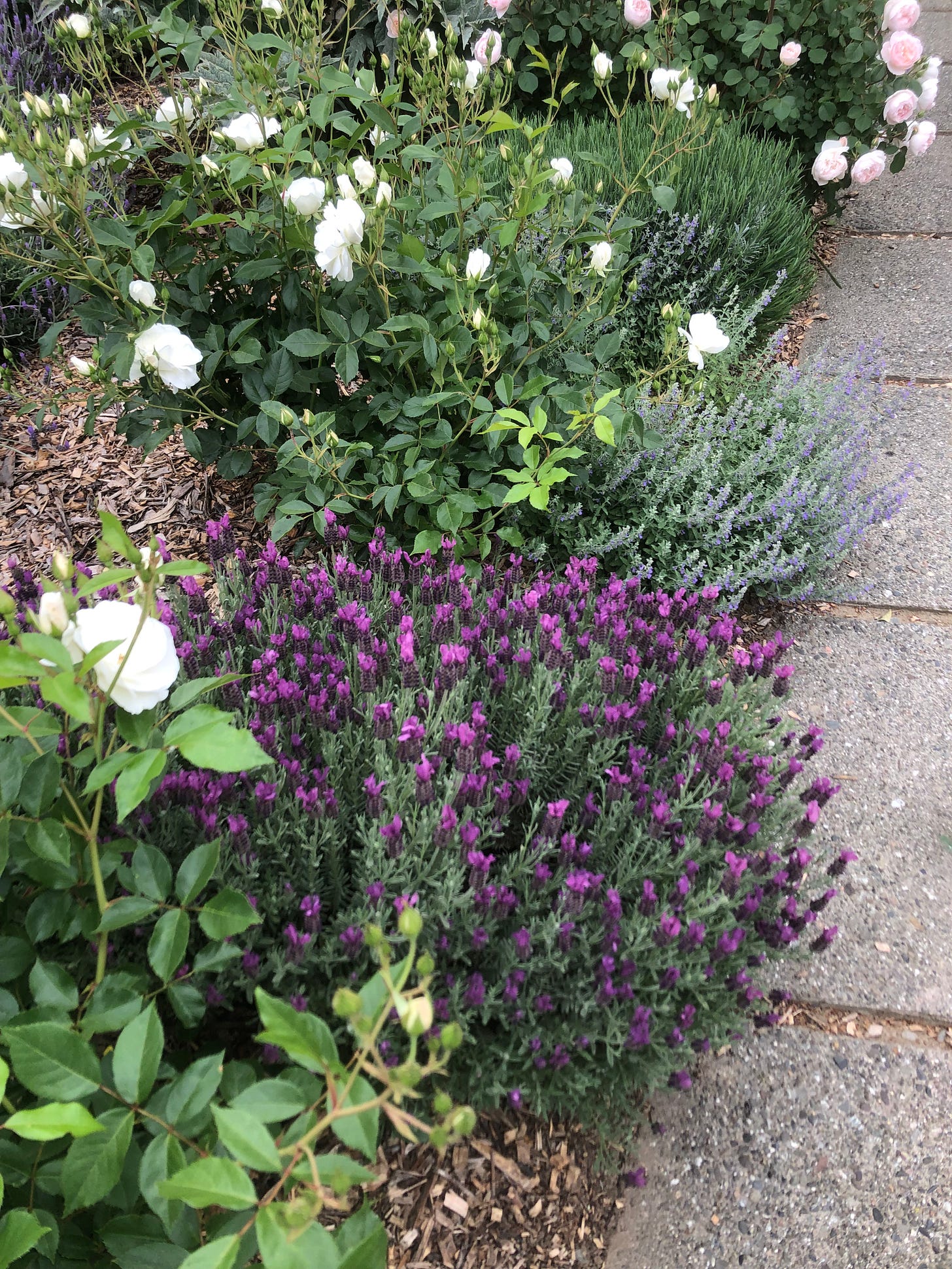
thoughts for the future of the garden
My goal with our garden is to provide a modest amount of food for us, well spread out over the year—so we’re not inundated with fruit at any one time, and so that there aren’t as many sparse times where there’s nothing to eat from the garden. Additionally, to provide enough flowers to both cut for bouquets and to enjoy in the garden as beautification. Our space is too small to eat exclusively from the garden, but I’m really proud of how much I’ve gotten our little space to yield with good care and planning.
I’d like to add an ‘O’Henry’ peach tree (late season) and maybe a white donut peach to round out our season—the peach we have now bears in July, and I love peaches—it would be my dream to have them all summer.
We had an old navel orange tree that died last year and we’ll replant one this coming winter, along with a Valencia orange to extend the citrus season (Valencias are summer bearing). To make space for two trees instead of one, we’ll cut out a shrub. Around the bases of the trees, I’ll plant daffodil bulbs (I don’t have any pure white daffodils yet, so probably will look for some of those, such as ‘Mt. Hood’) and near the border of the concrete, perhaps more roses and lavender.
I love rhubarb, and try to plant it again every year, but it never establishes here. I think our summers are too hot? We used to have a passionfruit vine but it got horrible barnacle scale and we ended up cutting it out— tragic, I know. I might try again for next year. Our garden is pretty great, though. No matter the season, there’s always something we can use from it to add to our table.
Please feel free to ask away in the comments, I am happy to answer any and all gardening questions to the best of my knowledge, and to provide encouragement! Gardening has been life-changing for me, and it’s always something I love to chat about.
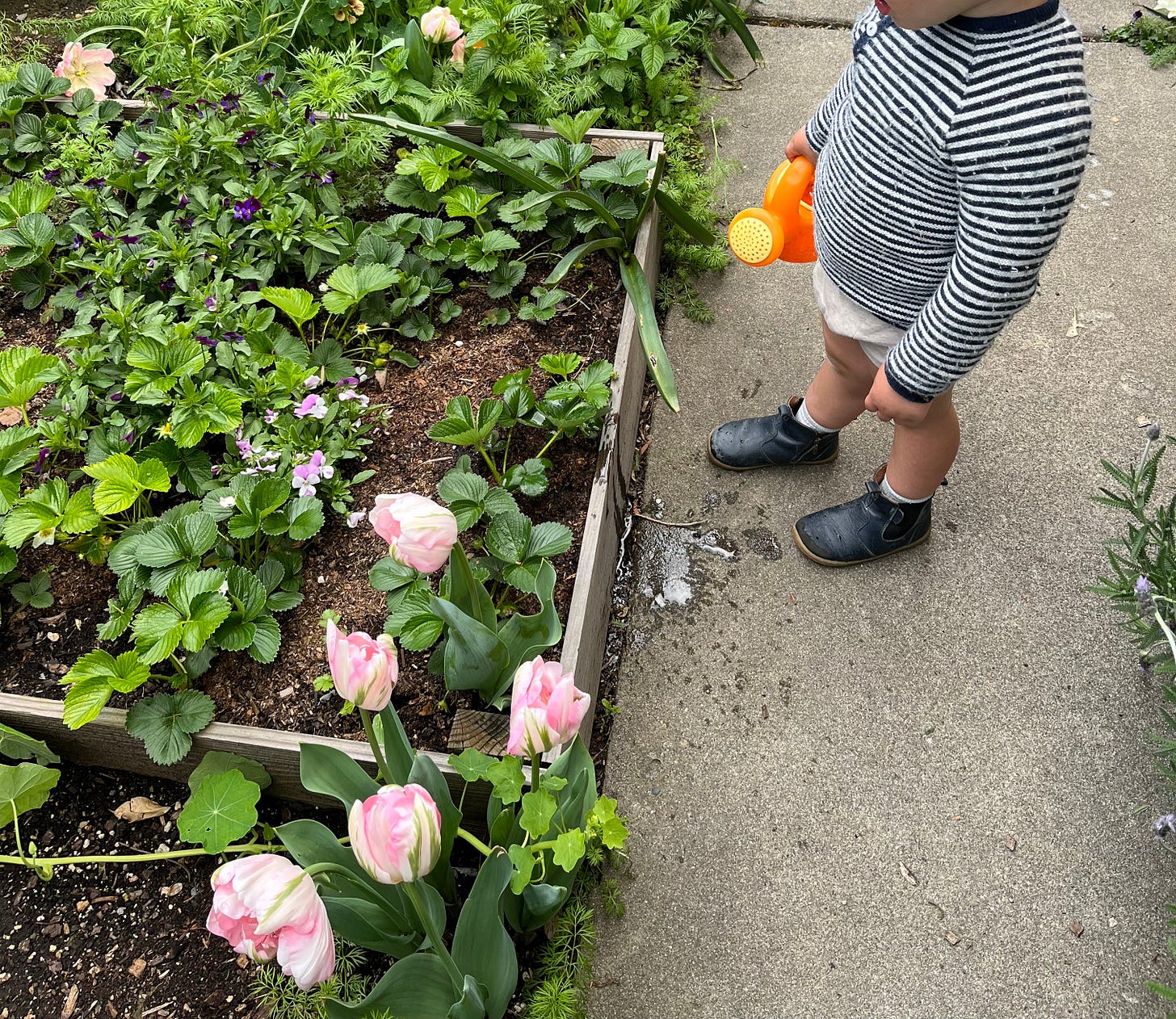
garden tour video
Come visit and walk with me around our backyard garden space to chat about all the plants, our compost system, and to see how things are set up. I tried to keep this as short as I could, but it still ended up 25 minutes long- oops! I guess gardening makes me chatty :)




